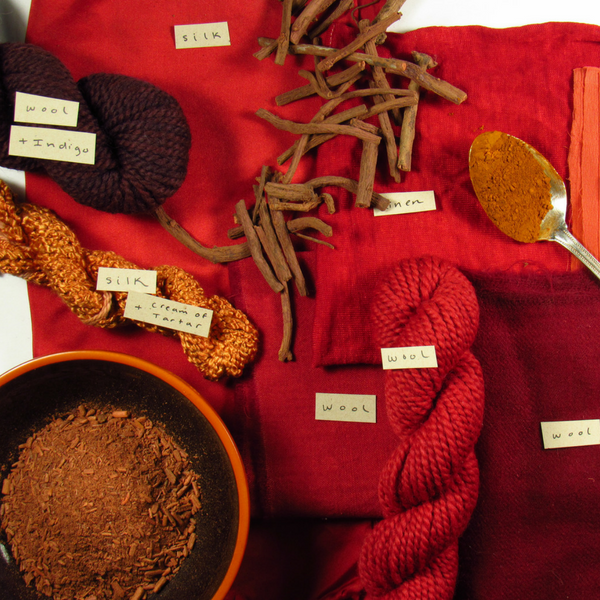This week: How to keep madder “fast” and is alum toxic?
Every week, we are emailed with questions from our natural dye community asking simple and complex questions that we thought might be worth sharing. Of course, all of your burning questions are answered by natural dyer in chief, Kathy Hattori, Founder of Botanical Colors.
How do you manage to keep the red dyes like madder fast? I have been struggling for a while now and very few of the reds/oranges want to play ball. Would love to hear your thoughts!
Madder is normally very fast (meaning that it is resistant to color change for washing and light exposure and rubbing) when properly dyed. If you are having problems, consider the following.
- The base fabric or yarn must be very clean, free of dust, dirt, oil and other finishes that can prevent the mordant and dye from adhering. Check out our How to Scour instructions.
- The fabric should be mordanted with the appropriate mordant for the fiber. Tannin + alum and soda ash creates a good base for cellulose fibers with good light and washfastness. Aluminum sulfate is a good base for wool fibers, again with good light and washfastness properties.
- Dyeing should occur using heat. While it is possible to dye without heat, I feel like I get better results if I heat a madder dye pot than if I dye at low or cold temperatures.
- Dye for the prescribed amount of time.
- Wash the dyed fibers well, and air dry out of direct sunlight.
I’ve seen very contradictory advice about how toxic alum is. Can you help me understand how potentially toxic it is to me, my kids, and the waterway? Thanks!
All of the chemicals we recommend for natural dyeing, including natural mordants such as tannins, have safety requirements for their use. This is different from toxic, which we define as “poisonous, carcinogenic, or directly harmful,” but they must be used responsibly. The information I have about aluminum sulfate is that it is not a toxic substance, nor is it chemically classified as toxic by regulating organizations such as OSHA, and IARC (International Agency for Research on Cancer), and it is not listed as a Proposition 65 chemical. But that doesn’t mean you can use it carelessly or with abandon and you should protect yourself from unnecessary exposure.
We always recommend the use of gloves, dust mask and safety glasses when measuring any mordants, and clean up any spills promptly. Dye in a well ventilated area and don’t breathe the vapors from a steaming mordant bath. This is true of any powder: you want to avoid breathing in powder or dust. You can dispose of a mordant bath in a municipal water system by diluting it with tap water. Even better, you can reuse the bath and save water and energy; we have information on reusing mordant baths here. If you are saving a mordant bath, store it securely and well-labeled as it is a clear liquid and looks just like water. All powders should be stored away from pets and children, and mordanting should be done under adult supervision.
Alum is actually used in wastewater treatment as it helps clean sewage so that the water can be discharged for further purification treatment.
All that being said, safe disposal means pouring down the drain. Any chemical released into a waterway has the potential to harm aquatic life, so avoid dumping mordants into lakes, creeks and streams.
And if you are really not comfortable using mineral alum, you can use plant hyper-accumulators like symplocos, which draws alum from the soil and stores it in its leaves. It works very well as a mordant for both animal and plant fibers and we’ve been pleased with its results. Other options for non-mineral mordanting include any plant tannin. But remember, these too are powders and the same precautions to avoid breathing powders should be followed.

